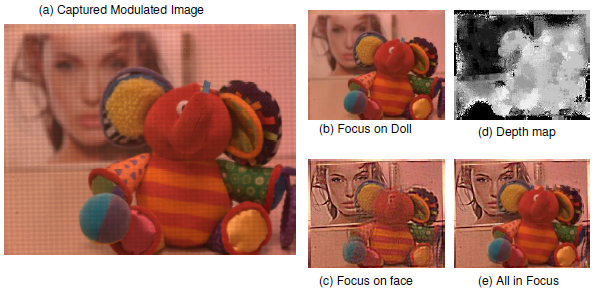TR2008-028
Non-Refractive Modulators for Encoding and Capturing Scene Appearance and Depth
-
- , "Non-Refractive Modulators for Encoding and Capturing Scene Appearance and Depth", IEEE Conference on Computer Vision and Pattern Recognition (CVPR), June 2008.BibTeX TR2008-028 PDF
- @inproceedings{Veeraraghavan2008jun,
- author = {Veeraraghavan, A. and Agrawal, A. and Raskar, R. and Mohan, A. and Tumblin, J.},
- title = {{Non-Refractive Modulators for Encoding and Capturing Scene Appearance and Depth}},
- booktitle = {IEEE Conference on Computer Vision and Pattern Recognition (CVPR)},
- year = 2008,
- month = jun,
- url = {https://www.merl.com/publications/TR2008-028}
- }
- , "Non-Refractive Modulators for Encoding and Capturing Scene Appearance and Depth", IEEE Conference on Computer Vision and Pattern Recognition (CVPR), June 2008.
-
Research Area:

Abstract:
We analyze the modulation of a light field via non-refracting attenuators. In the most general case, any desired modulation can be achieved with attenuators having four degrees of freedom in ray-space. We motivate the discussion with a universal 4D ray modulator (ray-filter) which can attenuate the intensity of each ray independently. We describe operating of such a fantasy ray-filter in the context of altering the 4D light field incident on a 2D camera sensor.
Ray-filters are difficult to realize in practice but we can achieve reversible encoding for light field capture using patterned attenuating mask. Two mask-based designs are analyzed in this framework. The first design closely mimics the angle-dependent ray-sorting possible with the ray filter. The second design [17] exploits frequency-domain modulation to achieve a more efficient encoding. We extend these designs for optimal sampling of light field by matching the modulation function to the specific shape of the band-limit frequency transform of light field. We also show how a hand-held version of an attenuator based light field camera can be built using a medium-format digital camera and an inexpensive mask.
Related News & Events
-
NEWS CVPR 2008: 8 publications by Jay Thornton, Shantanu D. Rane, Oncel Tuzel, Matthew Brand, Anthony Vetro and Amit K. Agrawal Date: June 28, 2008
Where: IEEE Conference on Computer Vision and Pattern Recognition (CVPR)
MERL Contacts: Matthew Brand; Anthony VetroBrief- The papers "Non-Refractive Modulators for Encoding and Capturing Scene Appearance and Depth" by Veeraraghavan, A., Agrawal, A., Raskar, R., Mohan, A. and Tumblin, J., "Feature Transformation of Biometric Templates for Secure Biometric Systems based on Error Correcting Codes" by Sutcu, Y., Rane, S., Yedidia, J.S., Draper, S.C. and Vetro, A., "Constant Time O(1) Bilateral Filtering" by Porikli, F., "Learning on Lie Groups for Invariant Detection and Tracking" by Tuzel, O., Porikli, F. and Meer, P., "Kernel Integral Images: A Framework for Fast non-Uniform Filtering" by Hussein, M., Porikli, F. and Davis, L., "A Conditional Random Field for Automatic Photo Editing" by Brand, M. and Pletscher, P., "Boosting Adaptive Linear Weak Classifiers for Online Learning and Tracking" by Parag, T., Porikli, F. and Elgammai, A. and "Sensing Increased Image Resolution Using Aperture Masks" by Mohan, A., Huang, X., Tumblin, J. and Raskar, R. were presented at the IEEE Conference on Computer Vision and Pattern Recognition (CVPR).